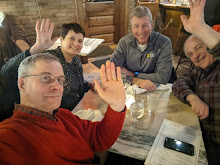
We've put up for the night in North Platte, Nebraska, at an out-of-the-way motel, run by an old-timer with a drawl and a beard, and rooms that Carolie says reminds her of the '50s. In other words: It's perfect.
Driving through Iowa and Nebraska has been exactly that. Nebraska rewarded one of our interests -- bird watching -- on the drive near Grand Junction with a massive migration of sandhill cranes, which we learned occurs each year between February and April. Thousands of cranes darkened the sky and were landing -- presumably for the night -- in fields along the North Platte River.

After entering Nebraska we stopped on the other side of Omaha for a look at the Great Platte Valley, which -- the marker says -- was the route of the fur traders and others, including the Mormons, on their move westward. Only the good people of Nebraska can explain why they plopped a public works building in the middle of the vista.

Highway historical markers are another one of my weak points. I stop to read them. In Glidden, Iowa, for example, there was a sign for the Merle Hay Historical Marker. So we stopped. It was a cemetary and this is only marker we could find.

So who was Merle Hay?
Wikipedia has the answer:
Merle David Hay (1896 – November 3, 1917) was the first Iowa serviceman and perhaps the first American serviceman to die in World War I, along with Corporal James Bethel Gresham of Evansville, Indiana and Thomas Enright of Pittsburgh, Pennsylvania.
All three men were a part of Company F, 16th Infantry Regiment, 1st Infantry Division (aka "The Big Red One") and in the trenches near Bathelémont-lès-Bauzemont in Lorraine (east of Nancy, France).
On the night of November 2-3, Germans trench raided their trench where all three were killed (possibly with Hay & Gresham initially and Enright when he resisted capture).
The outnumbered Americans were caught by surprise as they emerged from their wood and earth shelters to engage the enemy in hand-to-hand combat amid darkness and confusion. After 15 minutes the Germans withdrew and the barrage ended. Reinforcements reached the beleaguered Americans soon after to discover five wounded, twelve captured, and three killed.
Private Hoyt Decker saw Merle Hay battling two German soldiers with a bayonet in the dim, twinkling light of flares during the battle. Private Merle Hay was found face down in the mud after the attack with a .45 caliber pistol in his hand. The cause of death was a single 9 millimeter bullet wound beneath his right eye. His throat was also deeply cut. The watch his mother had given him had stopped at 2:40 a.m.
Hay, Gresham, and Enright were buried on the spot with a monument built which was later destroyed by Germans in 1940. Hay was then re-interred in July 1921 in West Lawn Cemetery in his home town of Glidden, Iowa. The West Lawn Cemetery was later renamed the Merle Hay Memorial Cemetery. An 8-foot monument commissioned by the Iowa Legislature marks his gravesite.
Shortly after Hay's death, the highway running from the west edge of Des Moines to Camp Dodge was renamed Merle Hay Road. A memorial boulder was placed along Merle Hay Road in 1923 and remains up today amidst the commercial development along the road.[1] Merle Hay Mall in Des Moines was also named for Hay; the local Kiwanis club placed a memorial plaque near the entrance to the mall's Sears store in 1979.
The first American military casualty in World War II was also an Iowa native. Andrew, Iowa, native Robert M. Losey, a military attache, was killed on April 21, 1940 during a German bombardment of Dombås, Norway. Captain Losey had been attempting to complete the evacuation of the American diplomatic legation from Norway to Sweden in the wake of the German invasion.
We didn't see Mr. Hay's grave, but came across a recent one. These things sure tell a story....trailer, pictures, beer, and Iowa Hawkeyes. (Click for larger image)

We stopped in Kearney, Nebraska for dinner. Once you get past the strip of chain restaurants and over the bridge over the railroad tracks (the Union Pacific freight trains come speeding through town without slowing down), there's a charming downtown with about 4-6 square blocks of actual retail.
As we drove across Nebraska, Carolie had a good thought, "Couldn't they have given the Indians some of these states?
Denver by lunchtime tomorrow, and Santa Fe by night

3 comments:
Bob - I don't know when you are coming back to MN, or what route you're taking, but as a student of ridiculous West-of-Mississippi Americana, your Nebraska post spurred me to suggest you work Carhenge in Alliance NE into your itinerary if at all possible. If you haven't been, you won't regret it.
Ah, yes, Michael Wells at work alerted me to this. We were just talking about finding this at dinner last night. We didn't know where it was and son, Sean, said we have to see it, too. It might be a bit out of the way from the route.
Very interesting. The information on the WWI casualties was very interesting. You never know what you are going to find.
Post a Comment